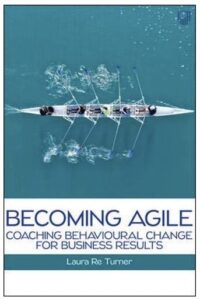
It was a pleasure to present a session today at the ICF Romania’s annual conference. Thank you to the terrific coaches who asked some great questions. I promised to publish my answers here, in addition to the discussion we had during the conference.
I prefer a wider definition of Agile development. I prefer ‘business agility’ because we know that a team gets only so far with Agile development before stakeholders in the organisation become blockers. At least this is often the team’s perception. Maybe business stakeholders’ mindset hasn’t changed. Maybe they aren’t familiar with the new approaches, or bought into the new frameworks and tools.
Knowledge is capital. Peter Drucker, the management guru, called the new skills “knowledge work” which differentiates a company in the marketplace. A business needs the skills and learning capacity to adapt to change from both internal and external sources.
So agility is needed, not just Agile. This is why I use the Six Lenses of Systemic Team Coaching, created by Peter Hawkins with the Academy of Executive Coaching.
Q&A
- Is it a structured program that needs to start from 1-6 or you can work on different levels based on the need? You’ll agree the aims and structure of the coaching engagement based on pain points (a tactical focus) or as part of a transformation programme. The Six Lenses is, to me, an observation tool that I use to ensure that coaching interventions are created from different perspectives. So it’s a model for seeing, not for contracting or commissioning.
- If you are in a team coaching setting (for a specific team related aspect) do you bring your observations about lenses 4, 5 and 6 into the team discussion? if yes, how? I ask how other stakeholders – naming one or two specifically – might view the situation. Any tools in your toolkit for helping someone see the situation from another’s perspective are relevant. And you don’t need to be working with the team to help people see from other perspectives, but this obviously comes up with teams all the time. “It’s not us, it’s them” is the kind of thing I hear. The agile team doesn’t understand the business perspective, and business stakeholders don’t often understand agile team practices. I’m generalising, but it comes up often.
- How do you get the client from the one to one coaching, which you said that it’s generally the way of start working with them, to the team coaching…. and also how do you generally structure your interventions? (talking now about the hybrid way of working and interacting) I don’t guide the client (the organisation) through each of the Lenses, I spent time working with and observing the client and putting together a picture for myself of where communication seems to be stalled, or people working at cross-purposes. Working with technology organisations, as we so often are asked to do when we’re working as an Agile Coach, we’re working with people who like data. I tend to agree that data is important – and there’s plenty of it on the team’s Kanban board as feedback which is quite tangible and relates to ‘time to market’, the all-important measure of how quickly we can get new products and services delivered. So it’s important to be able to engage as a coach but speak the language of Agile frameworks. Having that evidence (data / feedback) helps you to make the case to look at different interventions – in the other Lenses.
- How we can we identify on what level we should work with the team? All of them are important.
- This [Scenario Thinking] seems an approach of mitigating risks. Can we also think of trends or other opportunities in this phase? Yes it’s a way of identifying risks of change from the external business environment. By starting with a point in the future, in my example two years out, and working back to the present, we generate options for how to spot risks becoming issues. To turn the PESTLE analysis in Scenario Thinking into a way to identify opportunities, add a SWOT analysis as the second step of your facilitated process. Use your facilitation skills here.
My new book Becoming Agile: Coaching Behavioural Change for Business Results presents coaching approaches for working in all Lenses.

